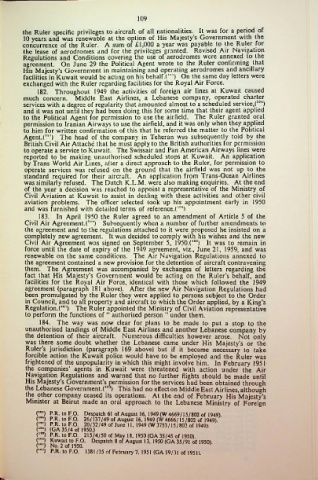Page 124 - The Persian Gulf Historical Summaries (1907-1953) Vol II
P. 124
109
the Ruler specific privileges to aircraft of all nationalities. It was for a period of
10 years and was renewable at the option of His Majesty’s Government with the
concurrence of the Ruler. A sum of £1,000 a year was payable to the Ruler for
the lease of aerodromes and for the privileges granted. Revised Air Navigation
Regulations and Conditions covering the use of aerodromes were annexed to the
agreement. On June 29 the Political Agent wrote to the Ruler confirming that
His Majesty’s Government in maintaining and operating aerodromes and ancillary
facilities in Kuwait would be acting on his behalf.(3M) On the same day letters were
exchanged with the Ruler regarding facilities for the Royal Air Force.
182. Throughout 1949 the activities of foreign air lines at Kuwait caused
much concern. Middle East Airlines, a Lebanese company, operated charter
services with a degree of regularity that amounted almost to a scheduled service,(30r')
and it was not until they had been doing this for some time that their agent applied
to the Political Agent for permission to use the airfield. The Ruler granted oral
permission to Iranian Airways to use the airfield, and it was only when they applied
to him for written confirmation of this that he referred the matter to the Political
Agent.C91) The head of the company in Teheran was subsequently told by the
British Civil Air Attache that he must apply to the British authorities for permission
to operate a service to Kuwait. The Swissair and Pan American Airways lines were
reported to be making unauthorised scheduled stops at Kuwait. An application
by Trans World Air Lines, after a direct approach to the Ruler, for permission to
operate services was refused on the ground that the airfield was not up to the
standard required for their aircraft. An application from Trans-Ocean Airlines
was similarly refused. The Dutch K.L.M. were also making enquiries. At the end
of the year a decision was reached to appoint a representative of the Ministry of
Civil Aviation at Kuwait to assist in dealing with these activities and other civil
aviation problems. The officer selected took up his appointment early in 1950
and was furnished with detailed terms of reference.O™*)
183. In April 1950 the Ruler agreed to an amendment of Article 5 of the
Civil Air Agreement^399) Subsequently when a number of further amendments to
the agreement and to the regulations attached to it were proposed he insisted on a
completely new agreement. It was decided to comply with his wishes and the new
Civil Air Agreement was signed on September 5, 1950.C00) It was to remain in
force until the date of expiry of the 1949 agreement, viz., June 21, 1959, and was
renewable on the same conditions. The Air Navigation Regulations annexed to
the agreement contained a new provision for the detention of aircraft contravening
them. The Agreement was accompanied by exchanges of letters regarding the
fact that His Majesty’s Government would be acting on the Ruler’s behalf, and
facilities for the Royal Air Force, identical with those which followed the 1949
agreement (paragraph 181 above). After the new Air Navigation Regulations had
been promulgated by the Ruler they were applied to persons subject to the Order
in Council, and to all property and aircraft to which the Order applied, by a King’s
Regulation.(4<n) The Ruler appointed the Ministry of Civil Aviation representative
to perform the functions of “ authorised person ” under them.
184. The way was now clear for plans to be made to put a stop to the
unauthorised landings of Middle East Airlines and another Lebanese company by
the detention of their aircraft. Numerous difficulties however arose. Not only
was there some doubt whether the Lebanese came under His Majesty’s or the
Ruler’s jurisdiction (paragraph 169 above) but if it became necessary to take
forcible action the Kuwait police would have to be employed and the Ruler was
frightened of the unpopularity in which this might involve him. In February 1951
the companies’ agents in Kuwait were threatened with action under the Air
Navigation Regulations and warned that no further flights should be made until
His Majesty’s Government’s permission for the services had been obtained through
the Lebanese Government.^05) This had no effect on Middle East Airlines, although
the other company ceased its operations. At the end of February His Majesty’s
Minister at Beirut made an oral approach to the Lebanese Ministry of Foreign
(a,s) P.R. to F.O. Despatch 61 of August 16. 1949 (W 4669/15/802 of 1949)
(”*) P.R. to F.O. 26/137/49 of August 16. 1949(W 4666/15/802 of 1949). *
(’") P R. to F.O. 20/32/49of June 11. 1949 (W 3753/15/802 of 1949)
(”') (GA 35/4 of 1950.)
(3") P.R. to F.O. 215/4/50 of May 18. 1950 (GA 35/45 of 1950).
/HI! Kuwa,t 10 F.O. Despatch 8 of August 13. 1950 (GA 35/91 of 1950).
(*') No. 2 of 1950.
(4#s) P.R. to F.O. 1381/35 of February 7. 1951 (GA 59/31 of 1951).

